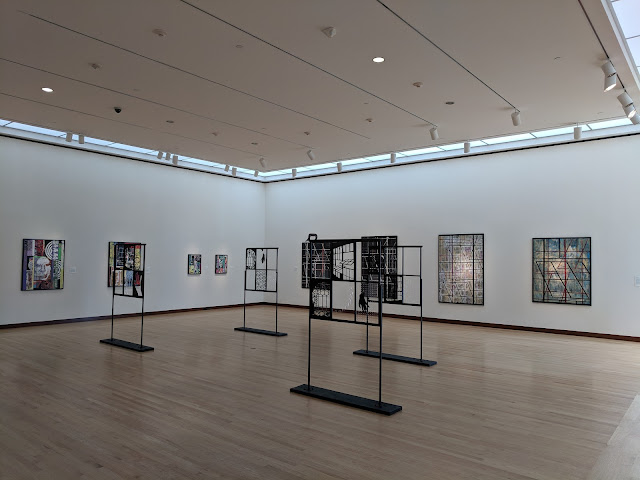- updated 05/15/2024
Paul is a consummate craftsman. His paintings and sculpture are highly refined and pristine.
The artwork that is represented in the New/Now show is tightly coupled to Paul's experience as a lifelong New Britain native, high school art teacher, and boyhood imprints. Much of his work employs both stencil and collage/assemblage techniques. The subject is often the effect of the industrial revolution on a town synonymous with manufactured hardware.
While the gallery narrative suggests the work has a relationship to the ubiquitous artistic trope of memory, I disagree. These pieces individually and as a whole are a super-fiction kitsch - a manufactured nostalgia. Less memory than a narrative of longing for an alternative history. One in which the trappings of the industrial revolution were still in play.
Contrast Paul's snapshot of industrial Americana with Thomas Hart Benton a few galleries over. Benton's America is about people, Paul's about location and things. Its a stark contrast. And Paul's work is most meaningful to the few individuals who similarly lament the passing of the twentieth century.
Many of Paul's sculptures and paintings invite us to peer through factory windows that obfuscate the reality that exited outside the window and the reality that existed inside the factory window.
As the son of a factory worker, I know first-hand the missing context. Yes, making hardware was honest work and grew a middle-class - good work for those whose calling in life was working with their hands, or back, or providing unquestioning compliance. And they made great tools and hardware components. This is what Paul's work celebrates.
What is missing are the worker's strikes that families suffered through, when stress resulted in physical violence at home, or scenes of workers in winter minding a warming fire while striking at street corners.
Nor does his work speak to workers who would sacrifice a finger to the machinery to pay a bill, feed a hungry child, or provide a down-payment on a better home.
The workers inside those windowed factories were men AND women whose hands and backs were sometimes deformed by the work. There is no identity politic literature that cares to speak of the conditions. Paul's work leaves it to your imagination. Maybe too much so.
I highly recommend seeing Paul's show. Its authentic and wholly contemporary - a pseudo-narrative by a New-Britain-as-every-industrial-town native who, like all of us, wonders where it all went to.
